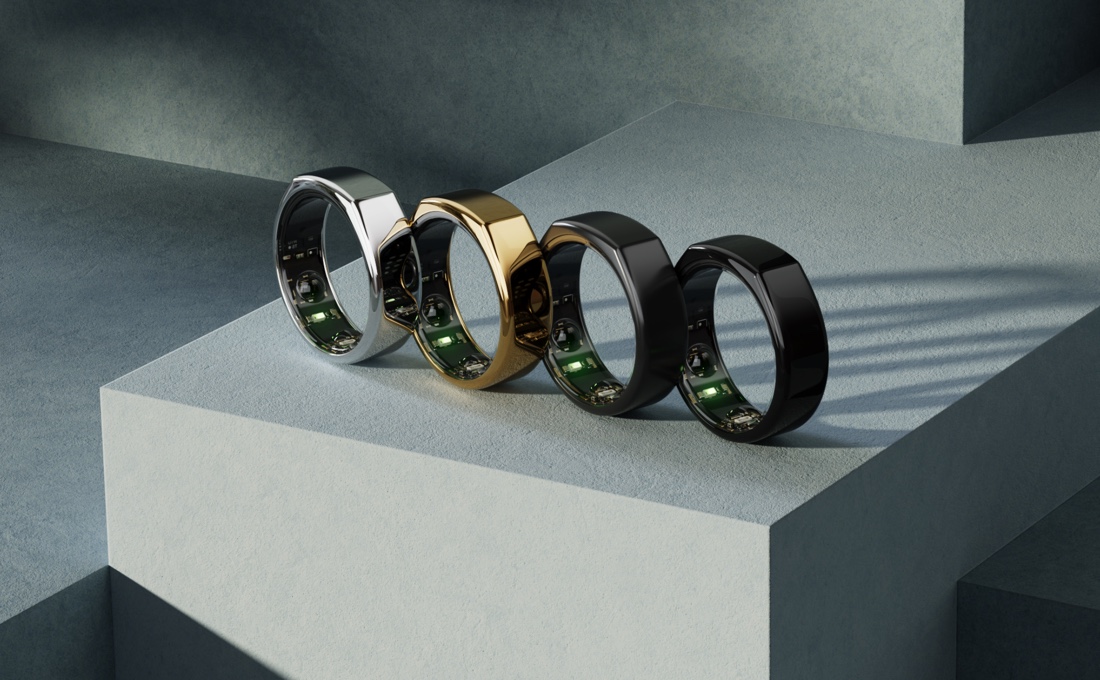

Oura just announced its generation 3 Ring. I have not used it myself yet but in this article, I break down the new features Oura announced with a critical lens. I will explain what each of these features means, what I find interesting and what I find less so. This will hopefully make you better informed about the new Oura ring Gen3 and help you decide whether to purchase it or not.
Oura ring Gen3 has 7 skin temperature sensors (compared to 3 in the previous generation). It uses NTC thermistors (special types of resistors that can detect changes as small as 0.1° celsius). There are a few challenges that have been shown in devices using this technology to measure skin temperature. The main issue is that normally, skin temperature is a few degrees lower than core body temperature because our peripheries are more easily affected by environmental changes in temperature. This can make it difficult to derive actionable insights about our core body temperature-a better reflection of our internal environment.
Oura tested this by conducting a study that analyzed the difference between a research-grade temperature sensor called iButton placed on the finger and a separate sensor which measured changes in the environment. It was done over a period of 2 days. The results show that the measured temperature from the finger better reflected body temperature rather than environmental temperature. One problem with this study is that it did not use the same sensor used by the Oura ring itself. Instead Oura relied on an unpublished “internal study” to claim that Oura Ring and iButton sensor have a 92% similarity. I would rather see published studies using Oura sensors directly.
Either way, I do believe Oura sensors are accurate enough to provide us with actionable insights. This feature is interesting because it gives us more information about what is happening in our bodies day-to-day. For example, skin temperature changes during different stages of sleep and may be used as a gauge to identify causes of poor sleep quality. It could potentially be used to guide our sleep environment temperature.
Skin temperature can also be used to detect stress and emotional variations. When stress levels are low for example, average skin temperature goes up. This adds a useful level of insight into our bodies’ inner workings when taken together with the other metrics Oura provides.
Oura announced a new period prediction feature which predicts when periods start up to 6 days in advance. This is not solely based on the calendar month but on sensing changes in body temperature that happen throughout the menstrual cycle. This is a great feature and is a clear example of the utility of temperature detection.
The most important component of the Oura ring is the heart rate sensor. Heart rate data is used by the Oura algorithm to create many of the useful metrics displayed on the app. Given that this is the main piece of input used by Oura to generate its insights, accuracy is crucial.
Oura measures heart rate by using a technology called Photoplethysmography (PPG). This is the same technology used by Apple Watch and Whoop band. It is composed of green LED lights (light-emitting diodes) that shine light through the skin. When the heart beats, there is an increase in blood flow through the tiny blood vessels under the skin. Because blood in the arteries is red, it reflects red light and absorbs green light emitted from the LEDs (the light that isn’t absorbed is reflected back). The more blood flows through the arteries under the LEDs the more green light is absorbed. The reflected light is picked up by a sensor called a photodiode which converts this information into an electrical signal that can then be used to calculate the metrics displayed on the app. Oura has added green and red LEDs to Gen3 (they haven’t specified how many). I presume this is to increase accuracy.
Gen3 now supports 24/7 heart rate monitoring which is a welcomed update. This allows for real-time heart rate monitoring while working-out or resting. The issue here is that previous generations of Oura have not been as accurate when measuring real-time HR compared to average HR. Some studies have looked at the accuracy of Oura HR measurements in comparison to the gold-standard for heart rate monitoring (electrocardiography or ECG) . While Oura was accurate enough in measuring overnight average HR, HRV (heart rate variability) and other related metrics, there were high error rates seen in measurements done over 5-minutes.
This is an issue with PPG technology in general. It is usually very accurate in measuring resting heart rate but becomes less accurate when measuring real-time variations (during exercise, for example). The same issue is seen with other wearables such as Whoop and Apple watch. PPG works best in areas with a high concentration of capillaries, this may be an advantage for Oura over wrist-based monitors.
This remains to be validated by a third party, but in my own experience and with our users at Span, we have found that real-time HR rate monitoring using similar devices is still a very useful guide for different situations such as exercise.
This is perhaps the feature I’m excited about the most. I previously wrote about the accuracy of Oura Gen2 where I concluded that Oura sleep tracking was not reliable when it comes to 4-sleep stage detection compared to Whoop. It looks like Oura has fixed this issue. They increased 4-stage sleep detection accuracy to an impressive 79% and 96% for 2-stage sleep detection. This is compared to 50-60% 4-stage accuracy in Gen2 (for comparison, Whoop 3.0 is closer to 70% accuracy for 4-stage sleep detection).
How did they achieve this? Here’s the breakdown:
The gold standard for sleep tracking is a lab test called polysomnography or PSG. In order to assess the accuracy of sleep metrics obtained from a wearable device, they are compared to this gold standard. Sleep detection is usually categorized into 2-stage and 4-stage detection. 2-stage simply means detecting wakefulness and sleep. 4-stage means detecting the 4 stages of sleep (NREM stages 1 and 2, NREM deep sleep or slow wave sleep and REM sleep).
In a published article authored by scientists affiliated with Oura, they explain how a combination of 4 different elements and machine learning was used to produce these results. Starting with accelerometer input (motion detector) and temperature measurement. They use this data to produce a 4-stage detection accuracy of 60%. The biggest improvement was seen when they included HRV to the mix which pushed 4-stage detection accuracy up to 76%. The final improvement was achieved by adding a model of the natural variation in sleep stages usually seen at night. This produced a final accuracy of 79% for 4-stage sleep detection and 96% for 2-stage sleep detection.
Sleep is one of the most important foundations of health. Accurate measurement of our sleep can provide us with huge insights that we can use to improve our health and well-being. This is why I think this feature is the most exciting new upgrade.
Oura ring Gen3 comes with infrared light emitting LEDs which are used to estimate oxygen saturation or SpO2. Hemoglobin is the main carrier of oxygen. The ring measures the amount of oxygen-carrying hemoglobin in the blood vessels under the skin compared to hemoglobin that is not carrying any oxygen.
There may be some utility to measuring SpO2 during sleep. It may alert us to underlying problems we would have otherwise not known about such as obstructive sleep apnea. That being said, I am less excited about this feature. Outside clinical settings, the vast majority of cases and conditions will show a normal SpO2. Normal SpO2 level ranges from 95% to 100%. SpO2 rarely changes in normal conditions unless the person has a significant health problem in which case I would expect them to know they had a problem based on their symptoms way before being alerted by a low SpO2.
In some cases, you may see a change in SpO2 during exertion such as in high altitudes due to a lower concentration of oxygen from the atmosphere entering the body. I have also come across a few cases of people with erroneous readings due to conditions that cause poor circulation in the extremities.
The new Oura membership promises access to daily insights, personalized recommendations and a library of guides and educational videos. I think this is a great step in the right direction towards a true and holistic health experience.
What’s much more important than how much data we track, is what we do with that data
The more data we have, the more confusing things can get. This is why relying on the right guidance and evidence-based experimentation is key to not just understanding our health but improving it. It is great to see more attention being directed towards this problem as this is exactly why we created Span.
I didn’t get into price and aesthetics in this review. These factors vary in significance from one person to another. In general, I am very impressed by the new Oura ring features, especially the new sleep detection technology. I hope HR detection is more accurate in this generation especially with live HR now being a feature. These updates definitely make me want to try it out personally. Make sure to follow me on twitter (@DrAdamBat) for more updates as we learn more.
https://www.mdpi.com/1424-8220/21/13/4302
https://ouraring.com/blog/temperature-validated-accurate/
https://www.dpag.ox.ac.uk/publications/95239
http://neurosky.com/2015/01/ecg-vs-ppg-for-heart-rate-monitoring-which-is-best/
https://link.springer.com/article/10.1007/s00484-009-0291-7
https://journals.sagepub.com/doi/full/10.1177/0748730417702974
https://www.ncbi.nlm.nih.gov/pmc/articles/PMC6021794/
https://pubmed.ncbi.nlm.nih.gov/26621099/
https://pubmed.ncbi.nlm.nih.gov/32713257/
https://www.tandfonline.com/doi/full/10.1080/15402002.2017.1300587?src=recsys&